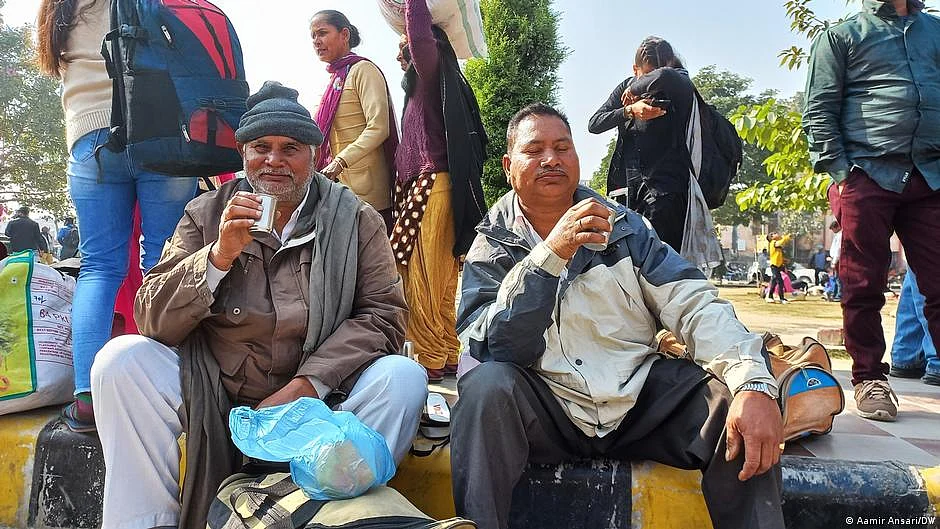India: Is poverty really decreasing?
India has revealed that almost 250 million people have been lifted out of multidimensional poverty. However, experts have raised doubts about the increasing lack of relevant data

Around 248 million people living in India escaped multidimensional poverty in the past nine years, according to a report by NITI Aayog, an Indian government public policy think tank.
The report suggests a 17.89% decline in multidimensional poverty over the last nine years, as the number of people living in this condition in 2013-14 was 29.17% — and it fell to 11.28% in 2022-23.
Indian states like Uttar Pradesh, Bihar, Madhya Pradesh and Rajasthan recorded the sharpest decline in the number of people classified as poor.
"The government has a goal to bring down multidimensional poverty to below 1% and all efforts are being made in that direction," said NITI Aayog CEO, BVR Subrahmanyam, following the publication of the report.
Does the MPI accurately reflect poverty?
Multdimensional poverty is based on health, education and living standards, each of which is given equal weight. The three categories are divided into 12 indicators.
Every household in India is given a score based on the 12 parameters and if a household has a deprivation score higher than 33%, it is identified as multidimensionally poor.
The MPI, also called the Alkire-Foster method, was developed by the Oxford Poverty and Human Development Initiative to measure the levels and intensity of poverty.
India has added two new parameters — maternal health and bank accounts — to its national MPI.
However, some economists have raised some serious doubts over the use of the MPI to make these claims, pointing out that the report does not paint the full picture.
Some have argued that the devastating impact of COVID on poverty is missing in the report's findings — while others point out that the number and share of the population below the consumption poverty line, the traditional method of estimating poverty globally, is absent.
Also Read: A fallacious definition of poverty
'Lack of relevant data'
Economist Santosh Mehrotra argued that the purpose of using the national MPI as the poverty indicator for India, despite an absence of consumption expenditure surveys between 2014 and 2022, is part of a political strategy.
"Real wages were stagnant for six years which had serious implications for consumption demands and this cannot be consistent with decline in poverty levels. The methodology is questionable," Mehrotra, a visiting professor of development economics at University of Bath's Center for Development Studies, told DW.
"Does the methodology and its results hold up to closer examination? Has the MDI been able to capture the full picture?" asked Mehrotra.
Lekha Chakraborty, professor and chair at the National Institute of Public Finance and Policy, pointed out that any composite index has limitations as it is highly skewed based on the specific choice of variables, as well as the methodology used.
"Even the Human Development Index (HDI) constructed by UN every year is not free from conceptual and methodological criticisms as it is based on only selected three indicators and the way weightage is given to each of the variables," Chakraborty told DW.
In her reckoning, data constraints thwart the meaningful constructions of such composite indicators and economists always use "proxy variables" or "extrapolate" the data.
"Poverty is dynamic, like chasing a moving target — using MPI for the policy decisions will be highly controversial," she added.
Controversies surrounding poverty estimates
The NITI Aayog report also claims that various government initiatives and welfare schemes have played a major role in mitigating different forms of deprivation.
Arun Kumar, a retired professor of economics from Delhi's Jawaharlal Nehru University, told DW that the government's report needs reinterpretation.
"There are lacunae. The health and education indicators which have the highest contribution to MPI were most adversely impacted in the pandemic year 2020–21," Kumar told DW.
"Using data from the fifth National Family Health Survey of 2019-21 must have led to substantial errors in the deprivation index based on the survey, opening the conclusions of the NITI Aayog report to suspicion," Kumar told DW, referring to a large-scale, multi-round survey conducted in a representative sample of households throughout India.
Controversies surrounding poverty estimates in India are not new and have been a subject of debate in the past as well over the estimation and methodologies employed.
Poverty numbers are important for assessing the economic progress of a country, and the government also needs these numbers to estimate the number of beneficiaries of schemes, such as the public distribution system for food, meant for poverty alleviation.
The World Bank defines the international poverty line at $2.15 (€1.97) in 2017 purchasing power parity terms daily to measure monetary value. PPP is a measure of the price of specific goods in different countries and is used to compare the absolute purchasing power of the countries' currencies.
In October last year, India ranked 111 out of a total of 125 countries in the Global Hunger Index (GHI) 2023, with its progress against hunger nearly halted since 2015, reflecting a global trend.
The GHI measures countries' performance on four component indicators — undernourishment, child wasting, child stunting and child mortality.
The government, though, contested India's performance, citing flawed methodology. In the index released, India has a score of 28.7, indicating a serious level of hunger.
Follow us on: Facebook, Twitter, Google News, Instagram
Join our official telegram channel (@nationalherald) and stay updated with the latest headlines
Published: 24 Jan 2024, 8:57 AM
